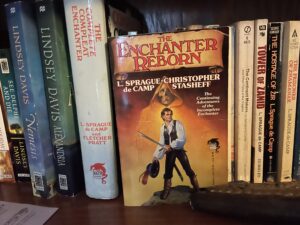
Despite the passing of Fletcher Pratt, Harold Shea lives on. The fantasy humor writer Christopher Stasheff tries to fill in, though the proceedure of story creation differs. The collection The Enchanter Reborn contains, rather than collaborations, individually written stories: two by Stasheff, one by L. Sprague de Camp, one by Holly Lisle, and one by John Maddox Roberts, (the latter two from outlines by de Camp and Stasheff.) So, rather than Pratt and de Camp working together to produce the stories, we have four authors writing individually. How does this change in the recipe affect the product? Let’s find out.
Professor Harold and the Trustees by Stasheff is more a refresher, a tidying up of loose ends, and a reset than a true Harold Shea story. Stasheff here, in his return to previously explored worlds, doesn’t truly capture the Pratt and de Camp feel. His actions scenes are slightly off, lacking the technical sport fencing lingo de Camp (I assume it was de Camp, judging from a dozen or so other de Camp books) liked to employ. And Harold seems less the opportunist than he was in Pratt and de Camp’s hands. Much of it seems a pointless exercise, since the purpose is utterly forgotten or dispensed with later on.
Sir Harold and the Goblin King by L. Sprague de Camp. de Camp and Stasheff clearly had not consulted with each other before writing. de Camp’s story directly contradicts Stasheff’s prior entry. In de Camp’s hands Shea reads like Shea again. Innuendo returns to the pages and Shea is slightly more calculating and less absorbed by moral niceties than Stasheff’s version. I’m not an Oz enthusiast and have little familiarity with the characters and setting. But I liked this one.
Sir Harold and the Monkey King, by Christopher Stasheff. I am familiar with the Chinese epic Journey to the West primarily through films, cartoons, graphic novels, and references in other texts. So I don’t know how accurate Stasheff’s take is. But it feels right. Yet neither Shea nor Dr. Chalmers (who accompanies Shea in this episode) attempt to discover and employ the particular magical system of this universe. So, absent one of the tent poles of the Harold Shea stories, this story sags. It still had its moments, though.
Knight and the Enemy by Holly Lisle. Again the lack of a coordinating editor for this anthology reveals itself. Lisle’s story states that it occurs following an excursion to the world of the Aenied. But Roberts’ story, which comes last, takes place in the Aenied. Also, it feels as if there is a missing story, unless I have forgotten an earlier tale that introduces Malambroso. (Which is entirely possible. Feel free to point it out to me.) Lisle’s tale brings Shea and Chalmers into the company of Don Quixote and Sancho Panza. And it is a lot of fun, full of humor and adventure. But the cleverest bit is that the story takes place — rather than in Cervantes’ novel — inside the universe as imagined by Cervantes’ character; inside the chanson de gesete warped mind of the Knight of the Woeful Countenance himself. It is gloriously metafictional, a story within a story within a story. Lisle windowframes this herself: Dr. Chalmers, on page 197, says “The universe is not a Chinese puzzlebox, Harold. Universes of fictions within fictions are improbable to the point of ludicrousness and –“. That’s great stuff.
Arms and the Enchanter, by John Maddox Roberts. Roberts has a great knack for colorful, telling detail. He skillfully includes little points showing that this world is Virgil’s conception of the ancient Mediterranean, rather than either Homer’s or the historical record’s. He gets the metafictional aspect, the humor, and the mechanics of magic aspect. He seems to have an excellent grasp of the underlying material; that is, both the Aeneid and the Enchanter stories. So the book ends on a high note, though it also ends with a cliff hanger. Which means there is more to come. Check back next week.
While you are waiting, pick up something of mine. As of this writing, it looks like you can get the entire four volumes of the Semi-Autos and Sorcery series for a good rate.

1 comment